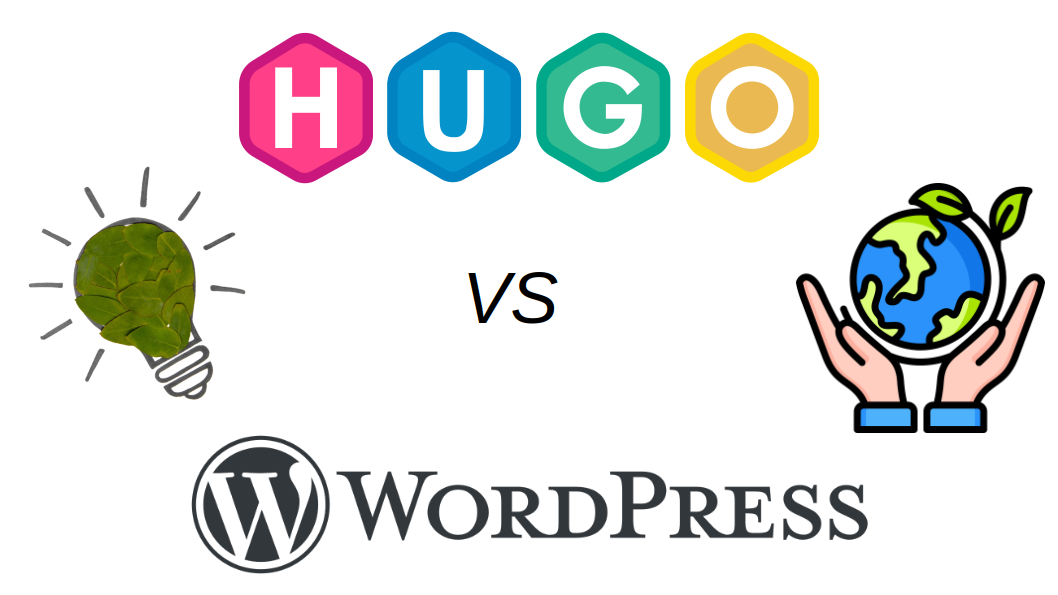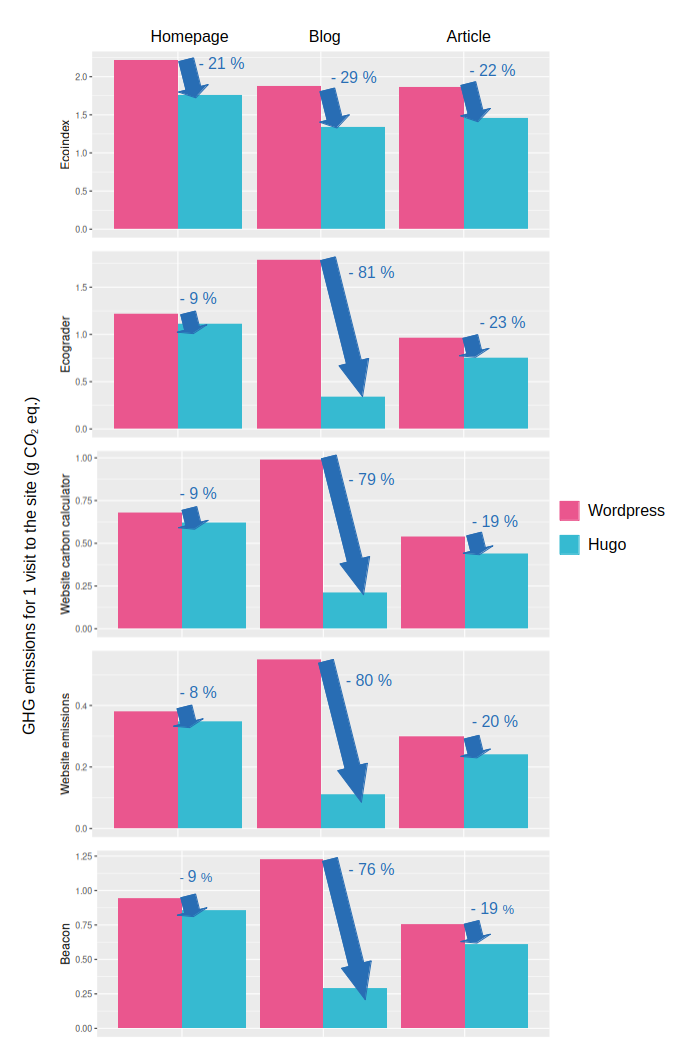Posted on
January 17th 2025
Tags
Hugo, a simple, performant and more eco-friendly alternative to Wordpress for websites

When it comes to creating a company website, there are many questions to ask : how to create it, how to organise the content, what design to choose, and many more… At Koevoo, we believe that, among the questions to ask, that of the environmental footprint of your website is especially important.
Wordpress : the most popular solution
One of the first decisions to make is which tool to use to create the website. And the most common answer to this question is : Wordpress. This open-source tool is a content management system (CMS) allowing the creation of both simple sites, such as a single presentation page, and complex sites, with access to customer accounts for example. Since its creation in 2003, Wordpress has been very successful, and some estimates suggest that over 40 % of websites worldwide use this tool(1).
Hugo : a simple and performant solution for static sites
However, for many companies, and especially for small and medium-sized enterprises (SME), more lightweight solutions, technologically speaking, are better suited for creating performant websites. Indeed, most of these companies want a website presenting their business, their offers ans their team ; allowing them to have a mobile version and maybe a blog or a contact form. These contents are called “static”, because unlike an invoice, they are invariably presented to each visitor. Hugo is a static site generator designed to meet these needs. For all cases where no customer account is required, this solution is lighter than a CMS (notably because it doesn’t use a database) and is perfectly suited.
Wordpress vs. Hugo : comparison of the environmental footprint
For the Koevoo website, we decided to do an experiment (detailed article to come) : we deployed the exact same site, once with Wordpress(2) and once with Hugo. The tool chosen to create the site was the only difference between these 2, otherwise perfectly identical, deployments. It allowed us to compare and to estimate the difference in environmental footprint between these 2 versions. In other words, it allowed us to estimate the impact of the choice of the underlying technology of a website.
Several online tools are available to estimate a website’s environmental footprint. These include, ecoindex, ecograder, website carbon calculator, website emissions, and digital beacon. Each of these tools uses its own methodology to estimate the site’s environmental impacts based on several indicators (more on these solutions in a future article). One common indicator to all the above-mentioned tools is the quantity of greenhouse gases (GHG) emitted per site visit (in g CO2 eq.).
We used these independent tools to compare the GHG emissions of 3 pages on our website : the homepage, the blog (page presenting the various articles) ang a blog article.
To complete this comparison, we also measured the amount of resources (processor and memory) used on the server side by each of the 2 deployments.
Comparison with online tools
For each page tested and for each tool, the Hugo website generates less GHG emissions than the Wordpress site.

Switching from Wordpress to Hugo allows the Koevoo website to emit between 8 % and 81 % less GHG, depending on the tool and the page considered, with an average reduction of 33 % in GHG emissions !
In 100 % of the tests, the estimated GHG emissions for the Hugo web page are lower than the ones for the Wordpress page.
Interestingly, the results are highly dependent on the page considered : the median gain is 9 % for the homepage, 79 % for the blog and 20 % for the article.
Comparison of the ressources used on the server side
While estimates of GHG emissions indicate a clear environmental advantage to using Hugo instead of Wordpress, environmental impacts are not limited to GHG. In our comparison of the 2 versions of the Koevoo website, we measured that the site using Hugo required at least 10 times less resources on the server side than the Wordpress site ! This measurement confirms the lower impact of Hugo and suggests that the difference in impact between Hugo and Wordpress could be even greater for certain criteria, such as the consumption of metals required to manufacture servers.
Hugo : a significantly reduced footprint
Wether through online evaluation tools or server-side resource measurement, the results of our experiment on the Koevoo site indicate that choosing Hugo over Wordpress significantly reduces the environmental footprint of the site.
An eco-designed website
Using Hugo to create your static website is thus a great way of limiting its environmental impact while at the same time getting a functional and easily maintanable site. After that, many additional practices, such as the choice of hosting and of the content, can be implemented to obtain an eco-designed website with the smallest possible footprint. Koevoo can assist you in the eco-design of your website, working towards a more sustainbable digital future.
💡 Tip !
At first glance, it may seem that Hugo requires more advanced coding skills than Wordpress, which has the advantage of offering a graphical interface suitable for non-technical users. However, if you’re worried about needing too much coding skill to use Hugo, know that you can greatly simplify the development process thanks to Penpot.
Penpot is an open-source alternative to Figma. This design tool allows you to create prototypes and graphical interfaces without having to write a single line of code ! A great way to enjoy all the benefits of Hugo, without the need for in-depth development skills.
(1) W3Techs Web Technology Surveys 40% of the web uses WordPress, February 10th 2021
(2) The Wordpress website used the Divi theme and builder
© Logo Hugo : Copyright 2014 Steve Francia ; Icons Dewi Sari, Freepik.
Explore the data with Koevoo :
Websites are hosted on servers, which have a limited capacity to manage several sites simultaneouslty. This capacity mainly depends on the resources that each site requires, in particular processors (CPU) and memory. The more resources a website requires, the less it will be possible to host a large number of them on a single server. Conversly, an optimized website, in terms of resources consumption, means that a larger number of sites can be hosted on the same server, thus limiting the manufacture of this equipment and the associated environmental impacts.
Both versions of the Koevoo website are deployed in Docker containers. To measure the impact of each version of our site on server resources, we use the docker stats command, which provides a detailed view of the resources consumed by each container. This method allowed us to compare the footprint of the 2 versions of our website on the server side.
Other posts
Every post >Contact
Let's meet !
Thank you for reading our blog. If you wish to find out more, feel free to contact us.
Koevoo needs the contact details you provide to contact you about our products and services. You can unsubscribe from these communications at any time. See our Privacy Policy to learn more about how to unsubscribe, our privacy policies and our commitment to privacy.
